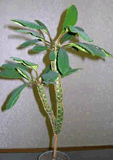Content
 Spurge
Spurge
belongs to the family of succulents that live in the subtropical forests of Africa and Madagascar. The genus Euphorbiaceae is one of the numerous, it has about two thousand species and subspecies.
In the wild, euphorbia grows very large, but even at room conditions this flower is not the smallest and even larger than average, for example, triangular euphorbia can easily grow to the ceiling.
Not everyone knows that milky poisonous juice is secreted on the sections of the stems of milkweed, which causes a chemical burn of the mucous membranes. Checked, by the way, empirically. Once we also tried to cut off one offshoot from the stem without gloves, as a result we got a burn on the lips, because then with these hands we allowed ourselves to touch our face. Be careful.
white spurge
It is distinguished by a ribbed trunk and elongated leaves with pronounced depressions at the site of the veins. His seeds start up in a box, and then scatter everywhere, including on the floor. And it is also believed that if you have spurge growing in your house, it means that you will be very happy.
One of the most beautiful is considered to be euphorbia - poinsettia. Its characteristic feature is bright red, pink or white leaves (depending on the variety), located under the inflorescences during flowering. And the flowers themselves are small. But due to the fact that keeping poinsettia in winter is too troublesome (due to dry air and drafts, it sheds leaves), it is often grown as an annual plant.
In principle, other types of milkweed take root quite well at home. In summer, they easily tolerate 25 degrees, in winter up to 10. They love bright rooms very much, they feel great on window sills facing southeast. That's just other flowers can not stand the neighborhood with this plant. When you determine the place for milkweed, keep this in mind too.
Watering is recommended moderate, if you overdo it, you will immediately notice that the leaves turn yellow. By the way, by winter, euphorbia always sheds excess foliage. During the vegetative period (from spring to autumn), you can feed fertilizer for indoor plants, or even cacti twice a month. When transplanting, leafy, soddy soils, humus and sand are used.
Euphorbia propagates by seeds, which themselves fall well into the ground, or by cuttings. Do not forget to sprinkle the sections on the parent plant with charcoal powder, and dry the stalk a little. Choose a good depth for planting: he likes to grow in large vessels.
Houseplant Care
![]() Transplanting Houseplants
Transplanting Houseplants
![]() Flower Pots: How to Choose
Flower Pots: How to Choose
![]() Houseplant Pests
Houseplant Pests
![]()
![]()
Houseplant Propagation Houseplant
![]() Fertilizers Hydroponics
Fertilizers Hydroponics
![]() Alocasia
Alocasia
![]() Aloe
Aloe
![]() Pineapple
Pineapple
![]() Araucaria
Araucaria
![]() Asparagus
Asparagus
![]() Aphelandra
Aphelandra
![]() Begonia
Begonia
![]() Geranium
Geranium
![]() Dieffenbachia
Dieffenbachia
![]()
![]()
Dracaena
![]() Cacti
Cacti
![]() Kalanchoe
Kalanchoe ![]()
Euphorbia
![]() Monstera
Monstera
![]() Tradescantia Ficus
Tradescantia Ficus
![]() Cyclamens
Cyclamens
PS If you liked the article, please press the buttons of social networks.

Leave a comment